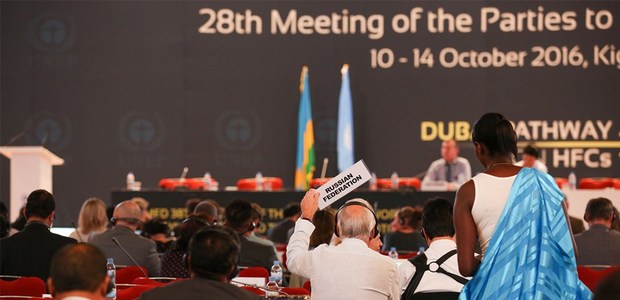Kigali: What’s in it for natural refrigerants?

The Kigali amendment is a step in the right direction, but the details don’t pack a hard enough punch.
The Kigali amendment agreed in October is the first change to the Montreal Protocol on ozone-depleting substances in the past decade. Though a great leap forward in the fight against climate change, the amendment nonetheless falls short of the high level of ambition boasted about in the run-up to the meeting.
An ambitious HFC phase-down – the low-hanging fruit of climate change mitigation – could prevent up to 0.5°C of global warming by 2100, bringing the world closer to its ambition of reducing overall warming by 1.5°C.
Many hail the Kigali deal as a step in the right direction. Initial reactions from governments, industry and NGOs were supportive. The EU’s commissioner for climate action and energy, Miguel Arias Cañete, declared the deal “a huge win for the climate,” arguing that it will help the world to stick to the promise made in last year’s Paris Agreement to slash half a degree off the median global temperature rise by the end of the century.
These ambitions will only be realised with a far more stringent agreement
The pace of the Kigali HFC phase-down is slow – almost too slow. The deal does not place enough emphasis on the opportunity to leapfrog HFCs in favour of new natural refrigerant-based technologies that are cost effective, energy efficient and readily available.
Given the technology solutions available today, developed countries could achieve their phase down of 15% of their baseline far more quickly than by 2036, the date agreed in Kigali.
For developing countries, the deadlines are even looser. The baseline years taken as reference for the phase-down are far into the future, allowing for increased use of HFCs before the eventual freeze and reduction. Split into two groups, they will only start freezing HFC use in 2024 or 2028, achieving the phase-down in 2045 or 2047 respectively.
The Kigali text recognises the need “to avoid transitions from hydrochlorofluorocarbons to high-GWP hydrofluorocarbons” but still offers flexibility if alternatives cannot be found. Necessity is the best stimulant for innovation, but the amendment is weak on necessity.
We’re stuck with this for a while
The amendment is inflexible yet will be operational for a long time. It will be difficult to change, with future alterations likely to require new decision texts rather than becoming part of the Montreal Protocol itself.
The most inflexibility can be found in the list of substances, which currently includes 19 known one-compound saturated HFCs. HFCs used in heating, air conditioning and refrigeration tend to be blends of these. Adding new substances to the list may take years. This is a problem – this list is not exhaustive, leaving substances such as unsaturated HFCs (so-called HFOs) on the market.
The HFC phase-down is measured in CO2 equivalents (GWP x kg of refrigerant), leaving the door open for the chemical industry to push new HFO-HFC blends onto the market whose GWP is still rather high. This will reduce industry’s incentive to shift away from HFCs. Adopting intermediary solutions would come at a high price for end users.
‘Low’ GWP might lead us to acid rain
The decision text fails to define high and low GWP, allowing substances that are comparatively noxious greenhouse gases to fall through the cracks and be classified as low GWP.
More worrying still is the risk of industry making another historic mistake. The decade since the Protocol was last amended has been the hottest on record. Temperatures are expected to keep rising. After damaging the ozone layer and warming the planet with CFCs and HCFCs, a new generation of fluorinated refrigerants are not only still on the table: their use is likely to grow.
The Kigali deal allows unsaturated synthetic substances to be considered ‘low GWP’ and therefore widely used as alternatives. Despite their lower GWP than HFCs, they break down in the atmosphere into trifluoroacetic acid, creating acid rain. Will we wake up in 10 years lamenting the damage done again? Or finally learn from past mistakes and avoid creating new problems when trying to fix existing ones?
Exemptions
The decision text fails to tackle the ‘high ambient exemptions’ issue. It allows countries where ambient temperatures are high countries to apply for exemptions from the HFC phase-down. What’s more, as the world gets warmer, more countries will become eligible for high ambient exemptions. The Kigali amendment fails to address this.
There is no reason for countries not to act. Innovation is quickly eroding arguments that high ambient temperatures compromise technological efficiency. Come 2032 the parameters will be entirely different.
No silver bullet
The Kigali amendment will deliver a global phase-down of HFCs. It also put the HVAC&R sector back in the global and mass media spotlight. Yet it is no silver bullet for the harmful effects of synthetic refrigerants.
The amendment was expected to be far more aggressive, saving us from the dangers of a two-degree rise in average global temperature. Phasing in refrigerants that will need to be phased out again is irresponsible when viable alternatives are already available on the market.
The decision text mentions ‘zero GWP’ alternatives but does not specifically name natural refrigerants. Natural refrigerants are the only genuinely sustainable solution. It is up to innovators to improve technological efficiency, legislators to create better standards, and educators to provide comprehensive training. These are the priorities that international negotiations must focus on.
